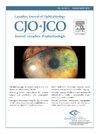Sensitivity of ophthalmologists, residents, and optometrists in identifying peripheral retinal tears on ultra-widefield imaging
IF 3.3
4区 医学
Q1 OPHTHALMOLOGY
Canadian journal of ophthalmology. Journal canadien d'ophtalmologie
Pub Date : 2025-03-04
DOI:10.1016/j.jcjo.2025.02.002
引用次数: 0
Abstract
Objective
To compare the sensitivity of 3 groups of masked graders with varying levels of ophthalmic training to identify peripheral retinal breaks utilizing ultra-widefield orthogonal, directed peripheral steering, and auto-montaged images.
Design
Retrospective observational cohort study.
Participants
155 patients from a single vitreoretinal specialist's practice.
Methods
221 eyes with pretreatment orthogonal, directed-peripheral steering, and auto-montage that underwent laser retinopexy for retinal tears between 2015 and 2021 were divided into 2 groups: treatment-naïve and control. Combined sensitivity and specificity of identifying all retinal breaks on orthogonal, directed-peripheral steering, and auto-montaged imaging were calculated compared with the gold standard of mydriatic, scleral depression examination. Linear probability modeling was performed to calculate the required surface area from auto-montage images to identify breaks that were missed initially on orthogonal images.
Results
For orthogonal images, combined sensitivity was highest for ophthalmologists (67.53%), residents (62.34%), and then optometrists (55.84%). The sensitivity increased for orthogonal/steering (ophthalmologists [85.71%], residents [77.92%], and optometrists [67.53%]) and auto-montage (ophthalmologists [85.51%], residents (80.28%), and optometrists [75.00%]). To ensure identification of all tears with auto-montage that was initially missed on grading the orthogonal image, for every 10% increase in montage surface area, there was a 4.8 percentage point (%p) increase in the likelihood of detecting a retinal tear on montage image grading (p = 0.023).
Conclusions
Masked graders had moderate sensitivity in identifying retinal breaks with ultra-widefield images. Even with directed-peripheral steering and auto-montage, optometrists had the lowest sensitivity compared to ophthalmology residents and general ophthalmologists and required increased surface area to identify all retinal breaks.
眼科医生、住院医师和验光师在超宽视场成像中识别周围视网膜撕裂的敏感性。
目的:比较三组不同训练水平的蒙面评分者利用超宽视场正交、定向外周转向和自动蒙太奇图像识别外周视网膜断裂的灵敏度。设计:回顾性观察队列研究。参与者:来自单一玻璃体视网膜专科诊所的155名患者。方法:选取2015 - 2021年行视网膜激光手术治疗视网膜撕裂的221只眼,采用预处理正交、定向外周转向、自动蒙太奇等方法,分为treatment-naïve组和对照组。计算正交、定向外周转向和自动蒙太奇成像识别所有视网膜破裂的综合灵敏度和特异性,并与金标准的瞳孔、巩膜凹陷检查进行比较。通过线性概率建模,从自动蒙太奇图像中计算所需的表面积,以识别最初在正交图像上错过的断裂。结果:正交图像中,眼科医生(67.53%)、住院医师(62.34%)和验光师(55.84%)的综合灵敏度最高。正交/转向(眼科医生[85.71%]、住院医生[77.92%]、验光师[67.53%])和自动蒙太奇(眼科医生[85.51%]、住院医生(80.28%)、验光师[75.00%])的敏感性增加。为了确保用自动蒙太奇识别所有最初在正交图像分级时错过的撕裂,蒙太奇表面积每增加10%,在蒙太奇图像分级中检测视网膜撕裂的可能性增加4.8个百分点(%p) (p = 0.023)。结论:蒙面评分者在超宽视场图像中识别视网膜断裂具有中等敏感性。即使使用定向外周转向和自动蒙太奇,与眼科住院医师和普通眼科医生相比,验光师的灵敏度最低,并且需要增加表面积来识别所有视网膜断裂。
本文章由计算机程序翻译,如有差异,请以英文原文为准。
求助全文
约1分钟内获得全文
求助全文
来源期刊
CiteScore
3.20
自引率
4.80%
发文量
223
审稿时长
38 days
期刊介绍:
Official journal of the Canadian Ophthalmological Society.
The Canadian Journal of Ophthalmology (CJO) is the official journal of the Canadian Ophthalmological Society and is committed to timely publication of original, peer-reviewed ophthalmology and vision science articles.

 求助内容:
求助内容: 应助结果提醒方式:
应助结果提醒方式:


